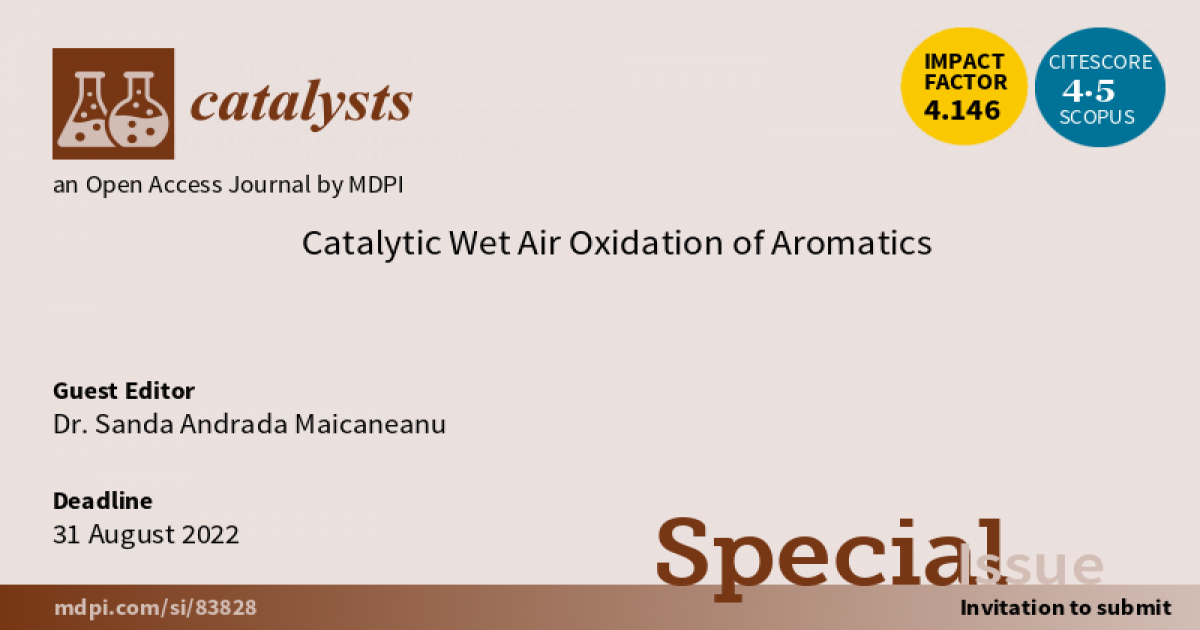Catalytic Wet Air Oxidation of Aromatics
A special issue of Catalysts (ISSN 2073-4344). This special issue belongs to the section "Environmental Catalysis".
Deadline for manuscript submissions: closed (31 August 2022) | Viewed by 2650

Special Issue Editor
Special Issue Information
Dear Colleagues,
Aromatics are important water pollutants, which are discharged from various industries. Their effects are ranging from modifying the photosynthetic reactions in water bodies to altering cellular metabolism and DNA in humans. Physical, chemical, and biological methods were all investigated for the removal of such pollutants from wastewater. In many situations, due to the high toxicity and resistance to biological treatments, chemical destruction of the organic compounds, to carbon dioxide and water, is desired. Wet Air Oxidation (WAO) is one of the available technologies, suitable for high organic loads and/or toxic contaminants. The main disadvantage of this method is the need of elevated temperatures and pressure. Alternatively, WAO in the presence of a catalyst, Catalytic Wet Air Oxidation (CWAO), reduces the severity of the reaction conditions, therefore reducing the cost of wastewater treatment. As research in the CWAO field expands strongly, this issue proposes to gather the latest developments in terms of catalytic systems and process requirements.
“Catalytic Wet Air Oxidation of Aromatics” Special Issue will include original research articles, comprehensive reviews, and short communications, on the topic, as defined by the keywords below.
Dr. Sanda Andrada Maicaneanu
Guest Editor
Manuscript Submission Information
Manuscripts should be submitted online at www.mdpi.com by registering and logging in to this website. Once you are registered, click here to go to the submission form. Manuscripts can be submitted until the deadline. All submissions that pass pre-check are peer-reviewed. Accepted papers will be published continuously in the journal (as soon as accepted) and will be listed together on the special issue website. Research articles, review articles as well as short communications are invited. For planned papers, a title and short abstract (about 100 words) can be sent to the Editorial Office for announcement on this website.
Submitted manuscripts should not have been published previously, nor be under consideration for publication elsewhere (except conference proceedings papers). All manuscripts are thoroughly refereed through a single-blind peer-review process. A guide for authors and other relevant information for submission of manuscripts is available on the Instructions for Authors page. Catalysts is an international peer-reviewed open access monthly journal published by MDPI.
Please visit the Instructions for Authors page before submitting a manuscript. The Article Processing Charge (APC) for publication in this open access journal is 2200 CHF (Swiss Francs). Submitted papers should be well formatted and use good English. Authors may use MDPI's English editing service prior to publication or during author revisions.
Keywords
- Catalytic Wet Air Oxidation
- Phenol
- Phenolic
- Dyes
- Mesoporous materials
- Catalyst preparation
- Catalyst characterization
- CWAO mechanism
- Pilot and full-scale applications
- Reactor design
- Process control
Benefits of Publishing in a Special Issue
- Ease of navigation: Grouping papers by topic helps scholars navigate broad scope journals more efficiently.
- Greater discoverability: Special Issues support the reach and impact of scientific research. Articles in Special Issues are more discoverable and cited more frequently.
- Expansion of research network: Special Issues facilitate connections among authors, fostering scientific collaborations.
- External promotion: Articles in Special Issues are often promoted through the journal's social media, increasing their visibility.
- e-Book format: Special Issues with more than 10 articles can be published as dedicated e-books, ensuring wide and rapid dissemination.
Further information on MDPI's Special Issue policies can be found here.





